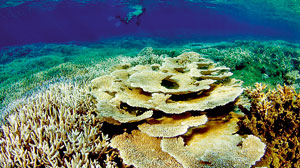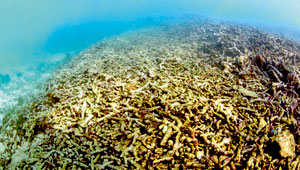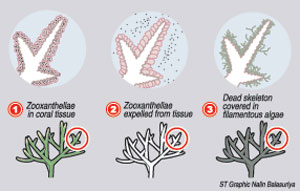Last year, The Sunday Times of May 16 reported that, sections of Pigeon Island corals were under bleach attack, and ‘dying’ a natural death. This exclusive article titled ‘Corals under Bleach Attack’ highlighted the need to monitor this pristine reef.
Recently, those who dived off Pigeon Island, confirm the worst has happened, with large areas of corals destroyed. But, are the guardians alert to monitor and protect this valuable reef?
 |
| Pigeon Island reef: Before bleaching – Pic by Nishan Perera |
 |
| Pigeon Island reef: Today – Pic by Dharshana Jayawardena |
Dharshana Jayawardena, who dived off the reef a few weeks back, says that many parts off Pigeon Island are like large coral tombs. The corals and marine life, once vibrant and beautiful, when Dharshana dived off the same area last year, were all gone, with only the discolored debris remaining.
Coral bleaching is one of the worst destructive natural phenomena faced by corals worldwide.
It occurs when coral polyps- the organisms that build corals, shed the algae zooxanthellae that give them their colour. These tiny algae, which live in harmony with the corals, also provide food for the host through the process of photosynthesis. Without this algae, the coral looks pale white and the coral polyps can be exposed to ultraviolet radiation.
Without food, oxygen or cover from dangerous rays, the coral polyps in the reef will die a few weeks after they start getting paler. When the sea surface temperature rises, corals start releasing this algae, triggering the bleaching.
The reasons for the bleaching last year was believed to have been the unusually high Sea Surface Temperature (SST) prevalent around the eastern parts of Sri Lanka, and the Sunday Times warned then that Pigeon Island corals too showed signs of entering into the first stage of such a bleaching, as warned by marine naturalist Prasanna Weerakkodi.
Researcher- National Aquatic & Research Agency (NARA), Arjan Rajasuriya, who studied corals, pointed out that the temperature at the Bay of Bengal, at that period of the year, had arisen to 34 degrees Celsius, although normal SST varies between 28 - 30 degrees Celsius. But last year, severe bleaching was recorded mainly in the Trincomalee area and the corals in the other parts of Sri Lanka suffered minor bleaching. Last year when Arjan dived Pigeon Island at end of May, he found extensive bleaching of the reef where more than 90% of the Corals were bleached. This bleaching was also observed in Dutch Bay according to the NARA Coral Expert. But surprisingly the bleaching restricted only to the Trinco area. Corals in Batticaloa suffered only minor bleaching as per Mr.Rajasuriya. He said that, this kind of sporadic bleaching was also reported in countries such as Maldives, Kenya, Mauritius too.
Coral bleaching has already become a serious problem in Sri Lanka and worldwide, pushing many of the coral species to the brink of extinction. It is believed that Global Warming makes it worse. The Indian Ocean experienced its worst coral bleaching in 1998, due to a warm oceanic current. The SST of some areas of the Indian Ocean had gone up due to the La Nina climatic phenomenon at that time, resulting in warm oceanic currents killing pristine coral reefs in many parts of Sri Lanka, including the Hikkaduwa coral reef that is still to recover.
 |
However, the corals off the East coast escaped the 1998 coral bleaching, though corals in nearby Batticaloa reef- some as deep as 42m, were bleached according to Mr. Rajasuriya. He believes the oceanic upwelling in Trincomalee, where the surfacing of cooler water from the deep, had lowered the SST, negating the effect of the warm 1998 El Nina current, saving Pigeon Island in 1998. Arjan says that, after 1998, sporadic bleaching was recorded on several reefs, but they were not widespread as the present case in Pigeon Island.
Director General, Department of Wildlife Conservation (DWC), Dr. Chandrawansa Pathiraja said he too had received information about damage to corals and the department was monitoring the situation. He said the department would obtain assistance from the National Aquatic Resources Research and Development Agency (NARA).
Ticketing causes inconvenience claim tour operators
The DWC started issuing entrance tickets at two of Sri Lanka’s Marine National Parks, Pigeon Island and Hikkaduwa. Local adults were charged Rs 40 per head, while a child was charged Rs 20, with a service charge of Rs 300 for a boat. Foreigners are charged US$ 10 per head, while US$ 8 per head was charged for a group. Boat fee is Rs 125 per visit.
Though they do not complain about the fee, tour operators and hotel owners say the ticketing process inconveniences tourists. All visitors have to come to the ticketing office located at Nilaweli for their tickets. However, unlike a terrestrial national park, where there is only one or two entry points, Pigeon Island can be approached from different locations. There are tourist hotels dotted around Nilaweli. For example, those who leave Nilaweli from nearby Uppuweli beach, will take an additional 20 min to land at Nilaweli for their tickets. Tourists (even ladies and children) need to help the boatman pull the boat ashore. When pulling the boat ashore, it could land on a passenger’s foot, if the tourist is on the wrong side of the boat, causing serious injury. Then the boatman has to go to the ticket counter, leaving the boat unattended, to fill a form and pay the money, where, more often than not, there is a queue, they complain.
Dive instructor Felician Fernando suggests that the DWC allows tour operators to buy tickets in advance, so that they could go directly to the island. He points out that it is the practice at the Cultural Triangle, where travel agents buy such round-trip tickets, and give same to the tour guide, to avoid delays.
Owner of Nilaweli Beach Hotel, who is also a diver, Travice Ondaatjie too says it is a logistical nightmare for everyone to come to the beach to buy their tickets, and requests that hotels be permitted to sell them.
Felician also points out the need for buoys to be positioned above coral reefs, when their clients dive. At the moment, boats have to drop anchor, sometimes causing coral damage when they fall on it.
Dr. Pathiraja commenting on the issue said an online ticketing system would be implemented within the next few months.
Marine scientists offer help – why not take it..?
The DWC is not alone, if it is really keen to protect these corals. The Sri Lanka Sub Aqua Club (SLSAC), which represents Sri Lanka’s diving community, is also willing to offer its assistance. Secretary- SLSAC, Naren Gunasekera said they are willing to offer their support to the DWC to monitor the reefs.
He stresses that scuba diving and snorkeling are important parts of the tourism portfolio that Sri Lanka has to offer. But most of these underwater sites are extremely delicate and need continuous monitoring and science driven management. It will also ensure that they remain in a state that can provide tourists a good experience (for example, to ensure that the bleached Pigeon Island reef is restored to ‘health’ within the next decade).
Unfortunately, there seems to be a lack of commitment from the DWC to engage these divers and other interested parties willing to give of their time to help educate the DWC on marine matters. Nishan Perera recalls, as part of a project in 2007, a complete ‘Marine Protect & Manage Area’ toolkit was compiled and handed over to the DWC. Alas, it has gone unheard. However, these marine scientists are still willing to offer their assistance to conduct free surveys and other services to manage underwater Ecosystems.
Marine scientists also complain that the DWC is a barrier to scientific research in these areas on many instances.
However, Dr.Pathiraja said the department was willing to to work with the scientists and diver community. |




